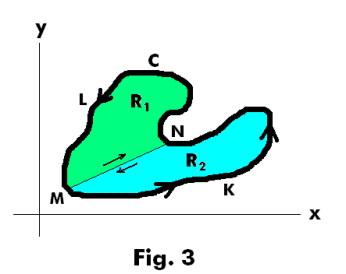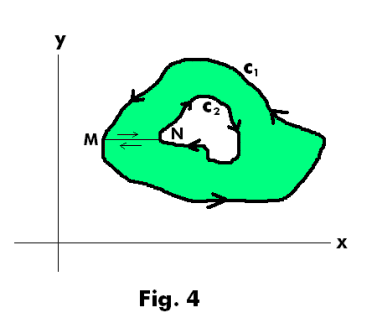
Website owner: James Miller
Prove. Let P(x, y) and Q(x, y) be continuous and have continuous partial derivatives in a region R and on its boundary C. Then

Proof. There are some difficulties in proving Green’s theorem in the full generality of its statement. However, for regions of sufficiently simple shape the proof is quite simple. We will prove it for a simple shape and then indicate the method used for more complicated regions. We will require such a shape that lines parallel to either x or y axis cut the boundary C of the region at no more than two points.
We shall prove the following two statements:



This will conclude the proof since the sum of 2) and 3) gives 1).
We shall now proceed to prove 2) and shall utilize Fig. 1. Let the boundary of region R consist of a lower curve y = Y1(x) and an upper curve y = Y2(x) as shown. Let c1 and c2 denote the lower and upper curves. Then
![]()
Computing the line integral for C1

where c and d are the limits shown in the figure.
Similarly, for C2 we have
![]()
Thus
![]()
Now let us consider the double integral in the right member of 2). It can be written as

By the Fundamental Theorem of Integral Calculus the integral within the brackets can be written as

and 5) becomes


From 4) and 7) we get

which is 2) above.
In a completely similar way we can obtain 3) above using Fig. 2. Then adding 2) and 3) we get 1).
How do we extend the proof of the theorem to more complicated shapes? We divide the more complicated shapes up into simpler regions of the type we have just considered using cuts such as the cut MN shown in Fig. 3. These cuts add to the boundary traversed by the amount of the cuts, traversed twice in opposite directions. Because they are traversed in opposite directions, the line integrals along the cuts cancel each other out, the net boundary traversed remains the same, and the theorem remains unchanged. More explicitly, referring to Fig. 3 we have


Adding the left sides of 9) and 10), omitting the integrands P dx + Q dy, we get
![]()
using the fact that

![]()
Adding the right sides of 9) and 10), omitting the integrands, we get
![]()
Consequently, from 11) and 12),

For more complicated regions we may need to construct more cuts dividing the region into more subregions.

Suppose the region is multiply-connected as shown in Fig. 4. How do we extend the proof to multiply-connected regions? For this we create a cross-cut MN, connecting the exterior and interior boundaries as shown in the figure, thus converting the region into a simply-connected region. The amount of boundary traversed is increased by the cross-cut MN, traversed in opposite directions. Because it is traversed in opposite directions the line integrals on the cross-cut cancel each other out and the net boundary traversed remains the same, namely c1 plus c2, and the theorem remains the same.
References
Spiegel. Complex Variables. (Schaum)
Taylor. Advanced Calculus.
Jesus Christ and His Teachings
Way of enlightenment, wisdom, and understanding
America, a corrupt, depraved, shameless country
On integrity and the lack of it
The test of a person's Christianity is what he is
Ninety five percent of the problems that most people have come from personal foolishness
Liberalism, socialism and the modern welfare state
The desire to harm, a motivation for conduct
On Self-sufficient Country Living, Homesteading
Topically Arranged Proverbs, Precepts, Quotations. Common Sayings. Poor Richard's Almanac.
Theory on the Formation of Character
People are like radio tuners --- they pick out and listen to one wavelength and ignore the rest
Cause of Character Traits --- According to Aristotle
We are what we eat --- living under the discipline of a diet
Avoiding problems and trouble in life
Role of habit in formation of character
Personal attributes of the true Christian
What determines a person's character?
Love of God and love of virtue are closely united
Intellectual disparities among people and the power in good habits
Tools of Satan. Tactics and Tricks used by the Devil.
The Natural Way -- The Unnatural Way
Wisdom, Reason and Virtue are closely related
Knowledge is one thing, wisdom is another
My views on Christianity in America
The most important thing in life is understanding
We are all examples --- for good or for bad
Television --- spiritual poison
The Prime Mover that decides "What We Are"
Where do our outlooks, attitudes and values come from?
Sin is serious business. The punishment for it is real. Hell is real.
Self-imposed discipline and regimentation
Achieving happiness in life --- a matter of the right strategies
Self-control, self-restraint, self-discipline basic to so much in life